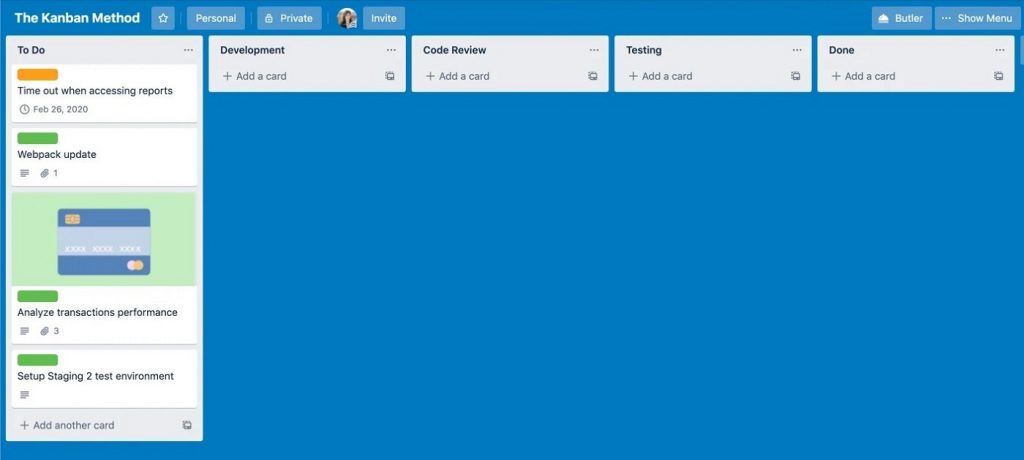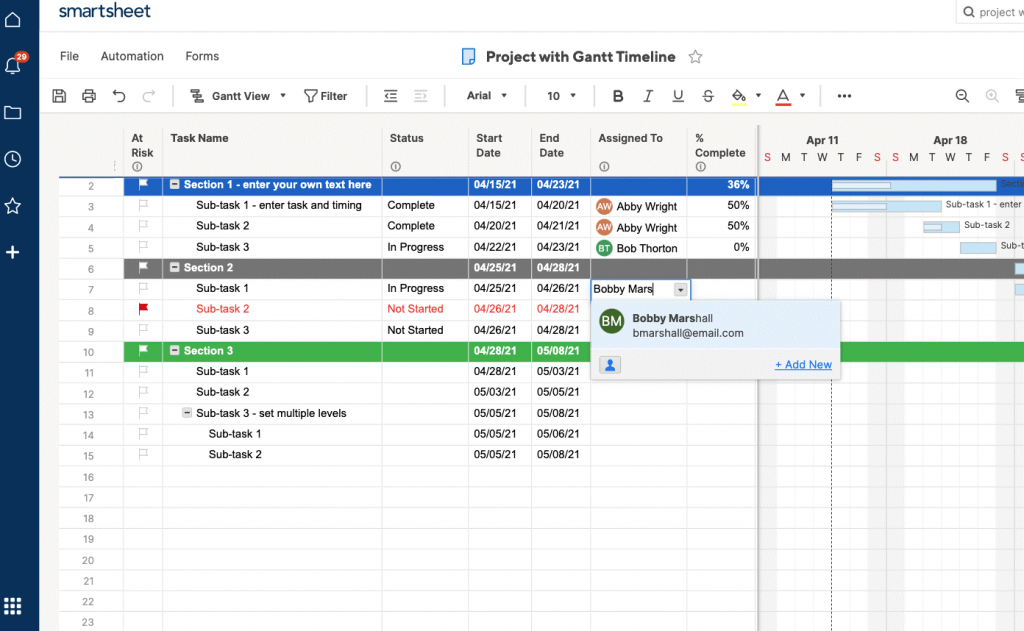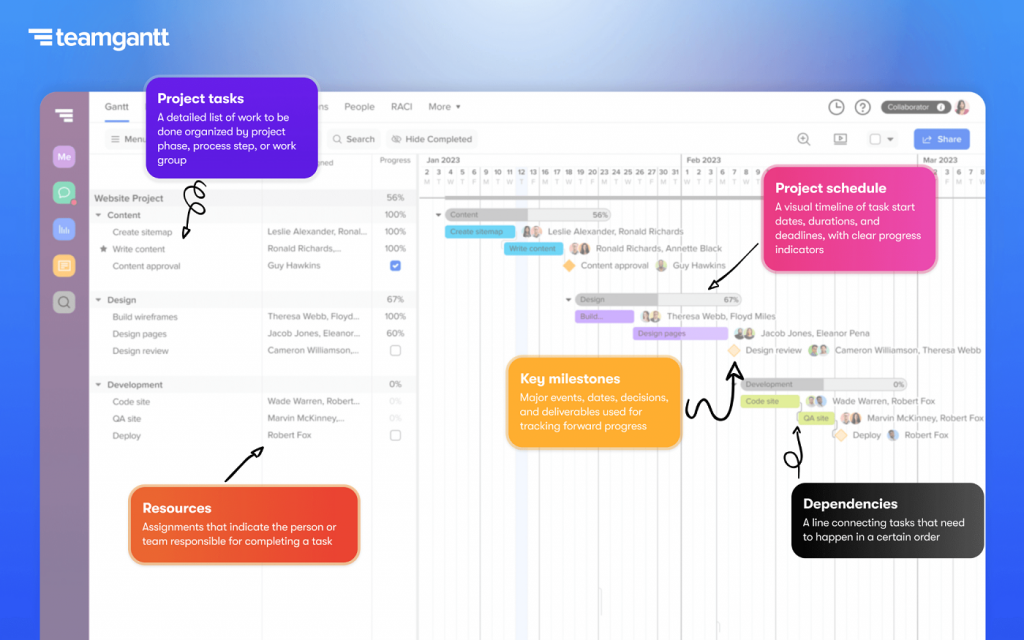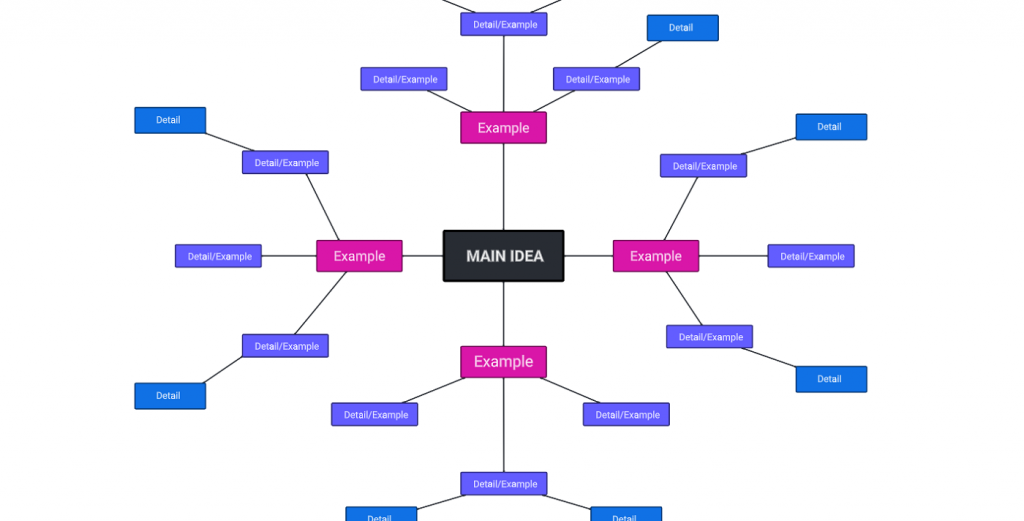


TechnologyAdvice is able to offer our services for free because some vendors may pay us for web traffic or other sales opportunities. Our mission is to help technology buyers make better purchasing decisions, so we provide you with information for all vendors — even those that don’t pay us.
Last Updated: April 30, 2024 Published Date: January 8, 2024Table of contents



Jan. 8, 2024: Irene Casucian reviewed the information on this page for accuracy, refined the page layout, and added elements to improve the visual flow of information. She also created a downloadable project plan template.
Show more Show less AdvertisementTechnologyAdvice is able to offer our services for free because some vendors may pay us for web traffic or other sales opportunities. Our mission is to help technology buyers make better purchasing decisions, so we provide you with information for all vendors — even those that don’t pay us.
A project plan outlines the project’s scope, objectives, and schedule; it details what needs to be done, when, and by whom. The plan includes significant deliverables, methods to achieve them, team roles, stakeholder feedback, and milestones. This transparency makes sure everyone involved understands their role and how it contributes to the overall goal.
A project plan is the tangible output of the second phase of project management, project planning. This phase involves identifying and arranging each task necessary to cover the project’s scope, achieve deliverables, and meet the project’s goals. A comprehensive project plan developed in this phase is instrumental in tracking dependencies, staying updated on the status, and maintaining productivity throughout the project.
A well-prepared project plan requires several key elements that will outline the project’s goals and define the stakeholders‘ individual roles. Incorporating these key elements into a project plan is essential for effective project management and a higher success rate.
| Element | Description |
|---|---|
| Executive summary | A concise overview summarizing the project’s purpose, scope, and significance. |
| Project goals | Specific, measurable objectives aligned with broader business aims. |
| Key responsibilities | Roles and duties of team members and stakeholders for accountability. |
| Key tasks and deliverables | Specific activities and expected tangible outcomes of the project. |
| Resources | Outline of available and required human, financial, and material resources. |
| Risk analysis and mitigation | Identifying potential risks and strategies to manage them. |
| Key milestones | Significant stages in the project timeline for tracking progress. |
| Project timeline | Schedule of tasks and milestones for time management. |
| Costs and budget | Financial estimates, budget allocation, and financial management plans. |
| Communication strategies | Methods and frequency of communication within the team and with stakeholders. |
Identifying your project’s overall objectives and goals will help you measure the project’s success and keep your team aligned with the overarching mission. In this step, you should determine the desired outcome of your project that would represent its success.
By clearly understanding what the project aims to accomplish, project managers and teams can better identify the necessary tasks and establish the project scope.
When defining your project goals, apply the SMART standards for a solid foundation. Make your objectives specific, measurable, achievable, relevant, and time-bound. This approach guarantees a clear, focused, and actionable framework for your project.
To measure success effectively, align your success criteria with the project’s key deliverables and outcomes, and make sure they are based on its intended result. Confirm that these criteria are quantifiable and accurately reflect the impact and value your project aims to deliver. Such alignment is essential for accurately assessing the project’s performance and its effectiveness in achieving the intended results.
To identify project milestones, break the project down into key tasks and outcomes and specify significant progress points or phase completions as milestones. Consider dependencies when establishing a realistic workflow. Additionally, identify potential risks that can impact task completion and define deliverables clearly as measurable results expected from each project phase.
Your project’s stakeholders include any individuals or groups related to the project. To assess if someone is a stakeholder in a project, determine how much they influence, impact, or have an interest in the project’s outcome. Consider if their involvement is direct, if the project’s results affect them, or if they can influence the project’s direction or success.
Examples of stakeholder groups include:
Once you have determined your stakeholders, you can define their roles and responsibilities. This can help you structure your project team, identify members who are directly responsible for its success, and make sure they are assigned the correct tasks to carry out the project appropriately.
When assigning roles and responsibilities, utilize a RACI chart (Responsible, Accountable, Consulted, Informed) to clarify the involvement of each stakeholder in the project. This provides clear communication and accountability and prevents overlaps or gaps in responsibilities.
Creating a schedule and timeline for each task can provide visibility into the execution process and keep each team member productive.
Consider how much time is required to complete each task necessary for your project milestones. You can even break down tasks into smaller subtasks to make them more manageable. However, be mindful of factors that can cause delays such as:
When creating a project schedule, visual tools like Gantt charts and Kanban boards help you map out task dependencies and timelines. A useful project management tool you can use for this step is Trello. Trello offers an intuitive platform for creating Kanban boards. It allows easy visualization and management of tasks through customizable columns and cards for streamlined project workflow.

To generate an estimated project budget, you must consider all of the necessary project resources, including personnel, labor, materials, and equipment. Establishing a project budget will help you make wise spending decisions throughout the project execution phase to avoid overspending.
A communication plan should show how information is shared among stakeholders. For instance, in a software development project, the communication plan might specify that the development team shares a beta version of the software with the client for feedback every two weeks. It’s a systematic approach to making sure that the client receives consistent updates about the project’s progress. Having a communication plan in place will also outline the channels of communication and frequency to all necessary parties. Leverage collaboration tools, such as Slack, that integrate with your project management software to receive real-time updates and interactions among team members and stakeholders.

Having these reports in one place will serve as a reference during the project’s execution.
Utilize a centralized digital platform, like Sharepoint, where stakeholders can store, update, and access all project documentation. This approach serves as a reliable reference and streamlines the management and tracking of the project’s progress.
Learn more about Sharepoint and other document management tools in our video overview:
Using an appropriate project plan format is essential to keeping stakeholders well-informed. Here are some of the widely-used project plan formats:
Using spreadsheets for project planning is beneficial due to its simplicity and widespread use, especially suitable for small-scale projects with straightforward tasks. Its customizable nature is excellent for simple initiatives like office events or basic marketing plans. However, a significant drawback of using spreadsheets in project planning is the limited visualization options. While spreadsheets can manage data, they fail to offer comprehensive visual representations essential for a holistic view of project progress. Lastly, the risk of human error in data entry and formula setup in spreadsheets is high and can lead to critical miscalculations affecting the entire project plan.
For more complex projects, Smartsheet is an ideal upgrade. It merges the simplicity of a spreadsheet with advanced project management features such as real-time collaboration, automated workflows, and app integration. More than just a basic spreadsheet tool, Smartsheet is particularly effective for large-scale projects like detailed marketing campaigns or cross-departmental efforts, offering comprehensive task tracking and resource management in a user-friendly format.

Slideshow presentations for project plans provide a visually engaging method to simplify complex information. They effectively break down project components into understandable segments, using visuals, charts, and bullet points to highlight key information and timelines for team members and stakeholders. However, the downside is that slide shows can oversimplify complex projects and potentially leave out critical nuances. They also require significant preparation time and may not be the best medium for detailed, data-heavy projects.
Microsoft PowerPoint is an excellent choice for creating slide show presentations as part of project plans. It’s user-friendly and offers many templates and design tools. That’s why it’s suitable for beginners and seasoned professionals. PowerPoint’s ability to integrate with other Microsoft Office tools, like Excel for data representation, enhances its utility in project planning.

Gantt charts create a clear visual timeline of a project’s schedule and progress by displaying various project elements’ start and finish dates. This approach helps identify potential bottlenecks and overlaps and facilitates better resource allocation and time management. However, Gantt charts can become cumbersome for complex projects with numerous tasks and dependencies. Gantt charts are particularly effective in construction projects, event planning, and software development, where timelines and task dependencies are critical.
TeamGantt is an effective PM tool that creates clear visual timelines for project schedules and progress tracking. By allowing users to input various project elements, including tasks, milestones, and dependencies, and then assigning start and finish dates to each, TeamGantt generates an intuitive Gantt chart. This chart visually represents the project timeline, displaying how different tasks and phases overlap and interconnect over the project duration. The color-coded bars and easy-to-read format make it simple to understand the sequencing of tasks and the project’s overall progress at a glance.

Mind maps differ from other project visualization methods by showing a radial, non-linear format ideal for brainstorming and capturing the holistic view of a project. They emphasize the creative mapping of ideas and relationships. They promote the free flow of ideas and easy visualization of relationships between different aspects of a project. Mind maps can also help identify key components, dependencies, and potential challenges at the early stages of a project. Moreover, using a mind map before presenting a Gantt chart can help ease the transition from creative brainstorming to detailed scheduling, resource allocation, and progress tracking.
Lucidchart is an excellent software solution for creating mind maps that can be converted into detailed reports. Its intuitive, drag-and-drop interface is ideal for conceptualizing project plans. Lucidchart also stands out because it integrates with various tools like Google Workspace and Microsoft Office. This integration can facilitate the transition from a visual mind map to a comprehensive written report.

Using a Work Breakdown Structure (WBS) in project planning offers distinct advantages and some drawbacks. The primary benefit of a WBS is its ability to break down a complex project into manageable components. It is then easier to allocate resources, assign responsibilities, and track progress. This hierarchical project decomposition guarantees that every part of the project is apparent. However, the main disadvantage lies in its potential rigidity; a WBS can become overly prescriptive, limiting flexibility and adaptability to changes or unforeseen challenges. Additionally, creating a comprehensive WBS can be time-consuming, and if not done meticulously, it may lead to gaps or overlaps in project planning.
monday.com includes a work breakdown feature to help teams organize complex projects into manageable tasks. Each task is separated into more minor subtasks assigned to the appropriate individuals. The chart also displays additional information, such as the deliverables, end dates, and schedules based on interdependencies.

Project and documentation management in project planning has its own advantages and disadvantages. With this process, you can make sure that all project-related documents are organized, up-to-date, and easily accessible. This approach is essential for maintaining consistency and clarity throughout the project lifecycle. Yet, the downside includes the possibility of information overload, where team members might get overwhelmed by the sheer volume of documents.
Agile teams use Jira for planning and managing their projects. Here, you can see some of the information regarding risks and dependencies compiled within Jira. This method of organizing this information can be helpful, as the platform can act as a single source of truth to keep team members updated on the status of specific tasks. It also makes it easy for teams to communicate with external stakeholders about factors impacting the project.

Effective project planning is the cornerstone of successful project execution. It involves several key aspects contributing to a project’s smooth functioning and success. Some of these benefits include:
Remember, an effective project plan is not just a document; it’s a strategic tool that integrates various critical elements to secure the project’s success.
AdvertisementTechnologyAdvice is able to offer our services for free because some vendors may pay us for web traffic or other sales opportunities. Our mission is to help technology buyers make better purchasing decisions, so we provide you with information for all vendors — even those that don’t pay us.